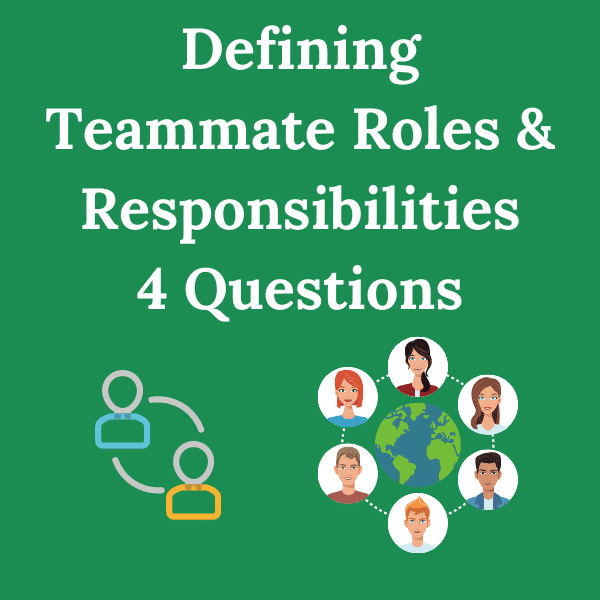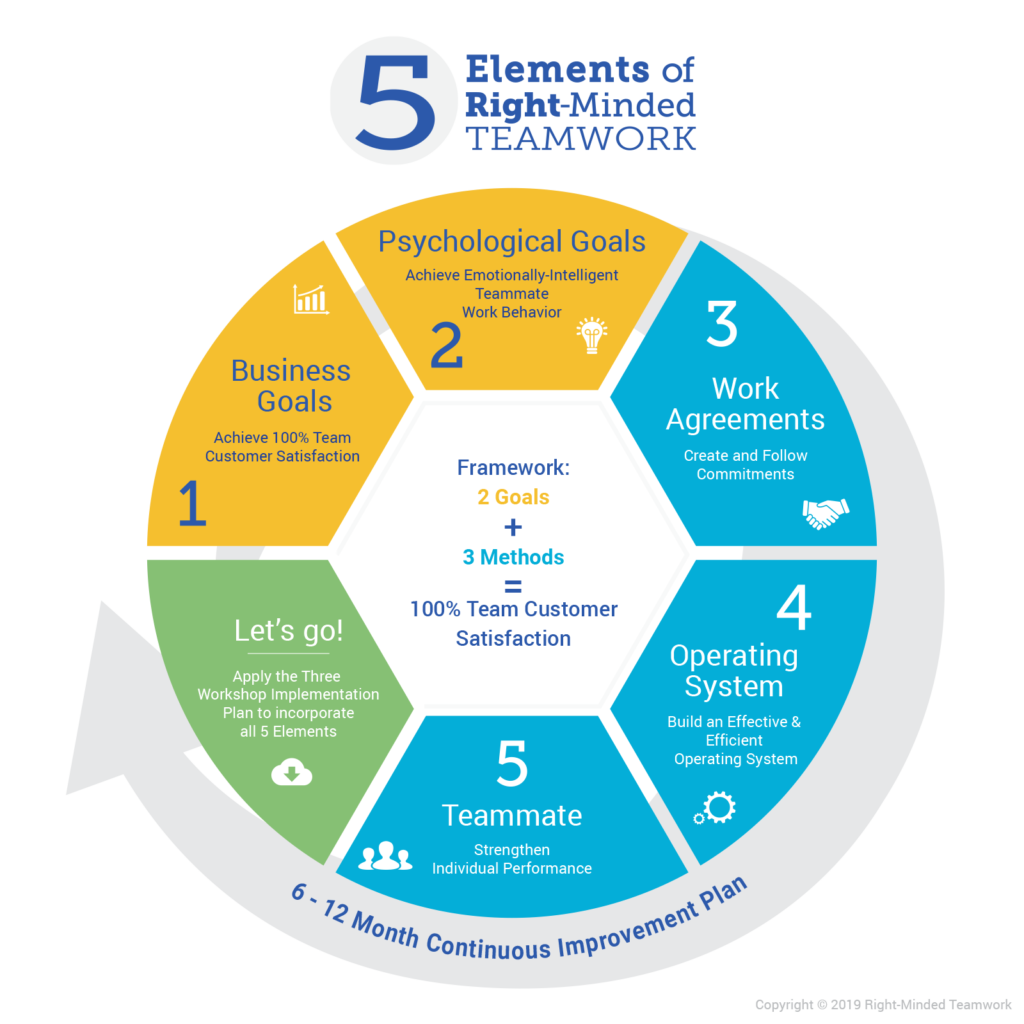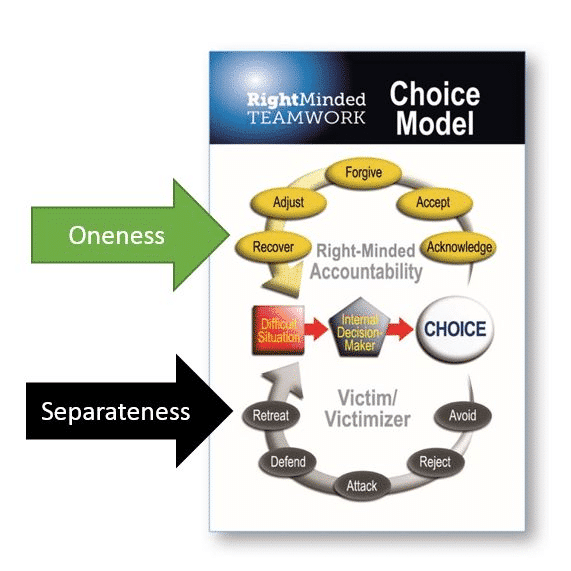Defining teammate roles and responsibilities, using these four questions, will increase the likelihood that your team will achieve 100% customer satisfaction.
- Why Clarify Teammate Roles?
- Pros & Cons of RACI Chart [Responsible, Accountable, Consulted, Informed]
- The 4 Questions [Detailed Instructions in Downloadable Guide]
- Bonus: 5 Additional Questions for Defining Roles
- One Final, Overriding Role – Oneness!
- Get Started: Download Leader’s Guide for this Team-Building Exercise
So many teams go off the rails because they do not know how to define and clarify teammate roles and responsibilities, or they simply do not take the time to make them clear.
Certainly, it does not have to be that way.
Clarifying teammate roles is a sure way to sustain high-performance teamwork. The 4-question team-building workshop is FASTER and BETTER than creating a complicated RACI Chart.
Once roles and responsibilities are clearly defined, just as preventive maintenance ensures your car runs properly, conducting a periodic team building workshop to re-clarify teammate roles and responsibilities will do the same for your team.
Why Clarify Teammate Roles?

If you do not perform this “maintenance,” teammates will start acting like an old clunky car.
When this happens, their timing is off. Instead of operating smoothly and efficiently, they burn oil and blow smoke.
No one needs that kind of poor teamwork behavior — especially when it is easily prevented with this straightforward teammate role and responsibility exercise.
Pros & Cons of a RACI Chart
One of the standard ways to clarify roles is to create a RACI chart. This team-building exercise defines individual or group Roles, Accountabilities, and who needs to be Consulted and Informed.
Pros:
RACI is an excellent and comprehensive process. Any team that creates an even moderately thorough RACI will benefit from the discussion required to create it. If teammates adhere to it as well, the benefits increase.
Cons:
For many teammates, creating a RACI chart takes too long. Also, it is useless if the team doesn’t follow it and periodically review it.
If you do not have a lot of time, or you are looking for a less complex method to define roles and responsibilities, the four-question approach will serve you better. It will provide clarity quickly, essential for preventing teammates from getting cranky.
The Four Questions
This is a two-step process for defining teammate roles and responsibilities using these four questions.
Firstly, let all teammates know about a week in advance that there will be an upcoming workshop to discuss roles and responsibilities.
In your announcement, include these four questions. Ask teammates to prepare their answers and bring them to the workshop.
Second, in the workshop, all teammates share their answers. Teammates will discuss their answers and either agree or modify their roles.
Finally, as a result of your workshop efforts, there will be a clear understanding among teammates regarding roles and responsibilities. In many cases, new team WORK AGREEMENTS.
Detailed instructions, plus an agenda, are included in the Leader’s Guide.
The four questions are:
1. What are the two or three deliverables, objectives, or products you produce for the team?
2. What resources or support do you need that you are currently receiving?
3. What resources or support do you need that you are NOT receiving now?
4. What are you getting that you DON’T need? What is preventing or getting in your way of doing your job?
For step-by-step instructions on how to set up and facilitate a role clarification team-building workshop, download the Leaders Guide.
In this video, Dan explains the Roles Exercise plus an attitude of teammate Oneness.
Bonus: Five Additional Questions for Defining Roles & Responsibilities
If your team is currently applying the 5 Elements of Right-Minded Teamwork, in addition to or in place of the four questions listed above, you can use these five questions.
Each question corresponds to one of the 5 Elements.
1. What are the specific roles or responsibilities you have that ensure your team achieves 100% customer satisfaction?
2. What tasks do you perform that help the team achieve its values, which are your team’s psychological goals?
3. What behaviors are you demonstrating that show you are living the spirit and letter of your team’s Work Agreements?
4. What responsibilities are you consistently demonstrating that ensure your Team’s Operating System runs smoothly and efficiently?
5. What, specifically, are you doing to nurture your Right-Minded Teammate’s attitude and performance?
Asking each teammate to produce a short answer to each of these five questions reinforces the 5 Element model and brings clarity to roles and responsibilities.
One Final, Overriding Teammate Role: Oneness!
As you implement your newly agreed-upon roles and responsibilities, it is vital that you do so while operating out of a deep-seated and heartfelt sense of OnenessOneness is a psychological state of mind. It can be described in many ways using phrases such do no harm, and work as one. Separateness is its opposite. More with your teammates and your team’s mission.
Oneness, at the team level, means:
- Teammates believe and behave as an interdependent and One‐minded team.
- They believe
- Do No Harm; Work as One
- None of us is as smart as all of us.
- Teammates believe in abundance, that the whole is greater than the sum of its parts (1+1=3).
- Teammates demonstrate in word and action personal accountability and an attitude of “We.”
The opposite of One‐mindedness is “separateness.” At the team level separatenessOneness is a psychological state of mind. It can be described in many ways using phrases such do no harm, and work as one. Separateness is its opposite. More means:
- Teammates believe and behave as separate and independent‐minded team members.
- They believe: “I am right, and you had better listen to me.”
- Teammates believe there is not enough (scarcity, or 1+1=1.5), so they attack [lower loop of Choice Model] to get what they think is rightfully theirs.
- Teammates demonstrate in word and action personal victimization and an attitude of “I.”
Teams may get by while operating in an atmosphere of separateness, but they never achieve their full potential in this state.
By definition, they pull in separate directions.
Separateness hinders performance by:
- allowing destructive competition
- encouraging little or no cooperation
- reinforcing power struggles
- feeding feelings of helplessness
- justifying finger-pointing and blame
Oneness helps performance by:
- encouraging and creating cooperation
- nurturing healthy competition
- empowering people to take accountability
The costs and benefits are clear.
It is far better to believe and act from Oneness.
Listen as Dan explains the importance of an attitude of teammate Oneness.
Conclusion: Conduct Exercise Every 6 Months
Defining and clarifying teammate roles and responsibilities, ideally once every six months is a practical exercise that ensures your team sustains high-performance teamwork.
Download the Leaders Guide for this Team-Building Exercise
Here are some actions you can take right now.
- Download the Defining Roles and Responsibilities Leader’s Guide to set up and implement your very own role clarification team-building workshop.
- If you think the above video on oneness will help your teammates, encourage them to watch it before the workshop.
- Consider using the Right-Minded Choice Model within the roles and responsibility exercise. It will help create a positive atmosphere for the workshop.
Need Support? Contact me and we’ll get you set up for success.

To Your Success,





